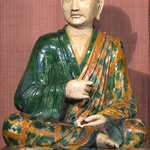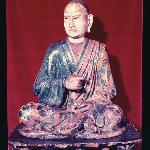| [Book] Hsu, Eileen Hsiang-ling. 2016. Monks in Glaze: Patronage, Kiln Origin, and Iconography of the Yixian Luohans.. Boston. Brill. Actual Citation |
View Objects related to this Actual Citation |
| [Article] Steinhardt, Nancy S. 2010. "The Luohan that Came from Afar". Expedition: The Magazine of the University of Pennsylvania Museum of Archaeology and Anthropology. Philadelphia. The University Museum. Vol. 52. no. 3. pg. 7-8 Actual Citation : Page/Fig./Plate: pg. 7 |
View Objects related to this Actual Citation |
| [Article] Steinhardt, Nancy S. 2008. "The Chinese Rotunda". Arts of Asia. Kowloon. Arts of Asia Publications, Ltd. Vol. 38. no. 5. pg. 83-95 Actual Citation : Page/Fig./Plate: Pg. 84, Fig. 14 |
View Objects related to this Actual Citation |
| [Article] Smithies, Richard. 2001. "A Luohan from Yizhou in the University of Pennsylvania Museum". Orientations (Hong Kong). Hong Kong. Orientations Magazine Ltd. Vol. 32. no. 2. pg. 51-56 Actual Citation : Page/Fig./Plate: 51 |
View Objects related to this Actual Citation |
| [Book] Winegrad, Dilys P. 1993. Through Time, Across Continents.. The University Museum. Actual Citation : Page/Fig./Plate: p. 62, fig. 53 |
View Objects related to this Actual Citation |
| [Book] Horne, Lee C. 1985. Introduction to the Collections of The University Museum.. Philadelphia. The University Museum. Actual Citation : Page/Fig./Plate: 60 |
View Objects related to this Actual Citation |
| [Catalogue, Collection] 1965. Guide to the Collections, The University Museum.. Philadelphia. The University Museum. pg. 1-167 Actual Citation : Page/Fig./Plate: p. 150 |
View Objects related to this Actual Citation |
| [Article] Jayne, Horace H. 1941. "The Chinese Collections of The University Museum: A Handbook of the Principal Objects". The University Museum Bulletin. Philadelphia. The University Museum. Vol. 9. no. 2-3. pg. 9-50 Actual Citation : Page/Fig./Plate: Frontispiece |
View Objects related to this Actual Citation |
| [Article] Jayne, Horace H. 01 Jan 1939. "Chinese Art at the University Museum". Parnassus. Vol. 11. no. 1. Actual Citation : Page/Fig./Plate: 7-11 |
View Objects related to this Actual Citation |
| [Article] Gray, Basil. 1936. "Chinese Sculpture: Examples at Burlington House". The Connoisseur: An Illustrated Magazine for Collectors. London. National Magazine Co. Vol. 97 (February). Actual Citation : Page/Fig./Plate: pg. 64, pg. 76 (ill.) |
View Objects related to this Actual Citation |
| [Catalogue] Royal Academy of Arts. 1935. Catalogue of the International Exhibition of Chinese Art.. London. Royal Academy of Arts. Actual Citation : Page/Fig./Plate: Pg. 209, No. 2438, Pg. 224, 2438 (illustration) |
View Objects related to this Actual Citation |
| [Article] Jayne, Horace H. 1935. "The Museum's Loan to Burlington House ( for International Exhibition of Chinese Art held in London 1935-36)". The University Museum Bulletin. Philadelphia. The University Museum. Vol. 6. no. 1. pg. 17-21 Actual Citation : Page/Fig./Plate: 7-11, pl. 6. |
View Objects related to this Actual Citation |
| [Article] Springer, Anton. 1929. "Die ostasiatische Kunst". Handbuch der Kunstgeschichte. Leipzig. Alfred Kroner Verlag. Vol. 6. pg. 43, 50, pl. 68 Actual Citation : Page/Fig./Plate: 111, 112 |
View Objects related to this Actual Citation |
| [Book] March, Benjamin. 1929. China and Japan in our Museums.. New York. American Council, Institute of Pacific Relations. Actual Citation : Page/Fig./Plate: 88 |
View Objects related to this Actual Citation |
| [Catalogue] Getz, John. 1916. The University Museum Exhibition of Oriental Art.. Philadelphia. The University Museum. Actual Citation : Page/Fig./Plate: No. 1, page 177 |
View Objects related to this Actual Citation |
| [Article] Bishop, Carl W. 1916. "Notes on Chinese Statuary". The Museum Journal. Philadelphia. The University Museum. Vol. VII. no. No. 3. pg. 152-177 Actual Citation : Page/Fig./Plate: 163, figure 165 |
View Objects related to this Actual Citation |
| [Article] Sayce, Archibald H. 1916. "Oriental Art in the University Museum". The Museum Journal. Philadelphia. The University Museum. Vol. VII. no. No. 3. pg. 149-151 Actual Citation : Page/Fig./Plate: Fig. 165 |
View Objects related to this Actual Citation |
| [Book] Hobson, Robert L. 1915. Chinese Pottery and Porcelain : An Account of the Potter's Art in China From Primitive Times to the Present Day.. London. Cassell. Vol. 1. Actual Citation : Page/Fig./Plate: 35 |
View Objects related to this Actual Citation |
| [Article] Bishop, Carl W. 1914. "A Pottery Statue of A Lohan". The Museum Journal. Philadelphia. The University Museum. Vol. V. no. No. 3. Actual Citation : Page/Fig./Plate: 129-135, fig. 69. |
View Objects related to this Actual Citation |
| [Catalogue, Exhibition] University of Pennsylvania, Office of the President. 1914. Catalogue of an Exhibition of the Art of the Far East.. Philadelphia. Actual Citation : Page/Fig./Plate: No. 7 |
View Objects related to this Actual Citation |
| [Article] Kummel, Otto. 1914. "Die Ausstellung Der Sammlung Perzynski Im Berliner Kunstgewerbemuseum". Ostasiatische Zeitschrift. Berlin. Oesterheld & Co. Vol. Jahrg. 2. no. Heft 4 Januar/Maerz. pg. 457-461 General Reference : Page/Fig./Plate: No. 7 |
View Objects related to this General Reference |
| [Article] Perzynski, Friedrich. 1913. "Jagd auf Gotter". Die neue Rundschau. Vol. (October). Actual Citation : Page/Fig./Plate: 1427 |
View Objects related to this Actual Citation |
| [Article] Jayne, Horace F. 1941. "Introduction". The University Museum Bulletin. Philadelphia. The University Museum. Vol. IX. no. 2-3. pg. pp.5-8 Actual Citation : Page/Fig./Plate: p. 5 |
View Objects related to this Actual Citation |






